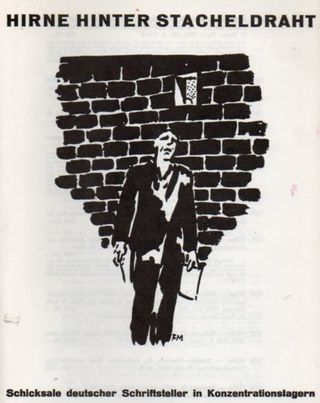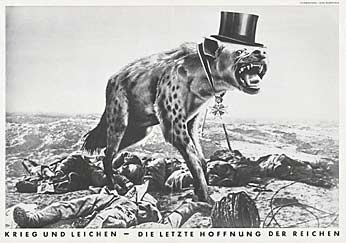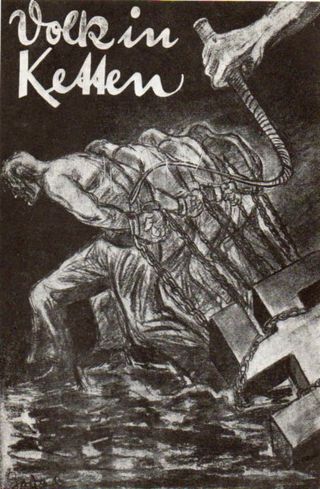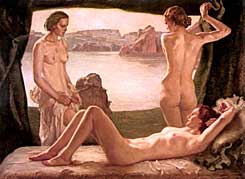JF Ptak Science Books Post 1731
I came upon this pamphlet out in the warehouse, and I was reminded again of the greatness and courage of some of the anti-NSDAP/Hitler artists in Germany in the early period of Nazism, 1933-1936. There were many who were overtly anti-Nazi--like George Grosz and John Heartfield--in the political messages that were their artwork; then there were those (like Felixmueller, Wollein, Otto Dix, Max Pechstein) who became enemies of the Nazi state because they chose to depcit the horrors of war or poverty or other social ills
 ["Brains Behind Barbed Wire", with a woodcut by Frans Masereel.]
["Brains Behind Barbed Wire", with a woodcut by Frans Masereel.]
John Heartfield, Blood and Iron, 1934

And then, as the Nazis consolidated power they erected an enormous edifice of propaganda and thought control, codified in law and absorbed into societal practice, where artists and writers and their artwork and books and ideas were banned, being "deliberate sabotage of national defense". The books were burned, the art removed or sold or destroyed or hidden, the writers and artists threatened with extinction as well: deported, thrown away, controlled, imprisoned, sent to concentration camps, murdered.

[War and Corpses, by John Hearfield, 1932.]
One way of another, they were mostly gotten rid of--the paintings and other works of those who were abroad or dead or otherwise not-reachable; and the art as well as the artists who were still in Germany, and whose presence could be controlled.
 ["Max Klinger", Volk in Ketten. Deutschalnds Weg ins Chaos, 1934]
["Max Klinger", Volk in Ketten. Deutschalnds Weg ins Chaos, 1934]
Some of the artists who were not able to escape, or who were Jewish and who did no tget sent to concentration camps, were murdered via the infamous Aktion 4 or T4 program--the mass murder of the physically disabled, the sick, the weak, the "moral degenerate", and those too incapacitated to take care of themselves. The name comes from the address of the organization responsible for it, at Tiergartenstrasse 4 in Berlin--the Gemeinnützige Stiftung für Heil- und Anstaltspflege, [or Charitable Foundation for Curative and Institutional Care] which was run from (at least ) 1939 to 1945 under the direction of Recihsleiter Philipp Bouhler (who unfortunately escaped life by suicide after being captured by the Americans in May 1945).
 [From Wiki: "This poster (from around 1938) reads: "60,000 Reichsmarks is what this person suffering from a hereditary defect costs the People's community during his lifetime. Fellow citizen, that is your money too. Read '[A] New People', the monthly magazine of the Bureau for Race Politics of the NSDAP."]
[From Wiki: "This poster (from around 1938) reads: "60,000 Reichsmarks is what this person suffering from a hereditary defect costs the People's community during his lifetime. Fellow citizen, that is your money too. Read '[A] New People', the monthly magazine of the Bureau for Race Politics of the NSDAP."]
To make things easier on the German mind, the NSDAP selected artists and entire art movements that were to be banned as "degenerate", and displayed them in an infamous 1937 show called Entartete Kunst ("Degenerate Art").
The people who committed their beliefs about the great Evil Thing that was National Socialism, those who committed their thoughts in art or literature, and did so in the 1933-1937 period, were brave people. Hitler and Goebbels and the rest of the Nazi machine deeply appreciated the influence of visual images, being great practioners in the idea themselves, only though with vastly different content.
The great social commentator/satirist/cartoonist for Harper's Weekly magazine, Thomas Nast, also knew the great influence of the single visual image, and magisterially used his insight and art to great effect in helping to effect social change. One of the evils he brought down--Boss Tweed of Tammany Hall--said that he didn't fear anything that was written about him in the newspaper because his constituency "couldn't read". But what he didn't get, and what he never did understand, that the thing that brought him down were cartoons, and those were the things that people didn't need to be able to read words in because they could already "read" the images. And it got him in the end.
The manufacturers of the NSDAP recognized this factor and saw how much it could play against them, and so sought to remove "it". They went after the art, the artists, and the ideas, and came away from it all with safe and sanitized and partially meaningless culture.
The artists condemned in the 1937 Degenerate Art exhibition necessarily reads like a who's-who of modern and 20th century art: the show included Ernst Barlach, Willi Baumeister, Max Beckmann, Max Ernst, Wassily Kandinsky, Emil Nolde, Max Pechstein, Paul Klee, Ernst Krircherm Lyonel Feiniger, Oskar Schlemmer, Franz Marc, El Lissitzky, Oscar Kokoschka, George Grosz, Marc Chagall, and Kurt Schwittersto name a few. (A full list can be seen below.) Entire artistic movements were also to be eliminated in order to save the morality and conscience of the German people, including Bauhaus, Surrealism, Impressionism, Fauvism, Expressionism, Cubism and Dada. Basically, it was almost all of modern art.
A fuller list of those exhibited at the 1937 Degenerate Art show.
These artist were abandoned/exiled/killed in favor of a more morally-robust and Aryan flavor, a genetic correctness, like the work here by Ernst Liebermann, moribund in its deadly color, greasy, tumescent hyper-non-sexuality:

which is picture postcard bad, like Franklin Mint artists gone to Nazism and shining/lustrous nudes.
The "degenerate" label didn't last very long in Germany, at least not in years--measured in lives, however, it is a completely different story.



Comments